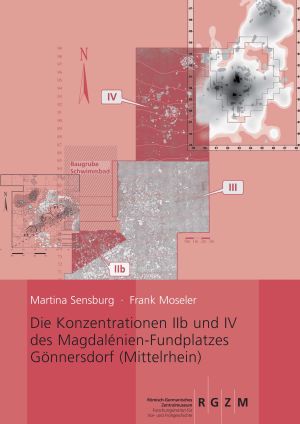Moseler, Frank
Die Konzentrationen IIb und IV des Magdalénien-Fundplatzes Gönnersdorf (Mittelrhein)
Der Magdalénien-Fundplatz Gönnersdorf bietet aufgrund seines Fundreichtums und der außergewöhnlich guten Erhaltung einzigartige Möglichkeiten der räumlichen Analyse eines jungpaläolithischen Siedlungsareals. Während die Konzentration IV bereits Gegenstand einer 1997 erschienenen Untersuchung war, handelt es sich bei Konzentration IIb um eine bislang unerforschte Siedlungsstruktur.
Die Konzentration IIb stellt eine Teilfläche der Großkonzentration II dar, deren zentrale Siedlungsstruktur (Konzentration IIa) bereits 2007 ausführlich behandelt wurde (Monogr. RGZM 69). Im Vordergrund steht nun, die Funktion der Siedlungsstrukturen in Konzentration IIb zu klären sowie ihr zeitliches und räumliches Verhältnisses zu den benachbarten Konzentrationen IIa und III.
Eine erneute räumliche Analyse von Konzentration IV erschien sinnvoll, da sich besonders digitale Analyseverfahren seit der Erstbearbeitung erheblich verfeinert haben, und nun einige vormals unbehandelte Teilaspekte untersucht werden konnten. Das führte hinsichtlich der Beziehung zwischen latenten und evidenten Befunden sowie der Artefaktherstellung in K–IV zu detaillierten Ergebnissen.
Brandstrukturen im späten Magdalénien: Betrieb, Nutzung und Funktion
Die Nutzung des Feuers war einer der entscheidenden Meilensteine in der Evolution des Menschen und seines Verhaltens. Im Laufe der Jahrhunderttausende gewann das Element Feuer immer mehr an Bedeutung. Bis heute kommt ihm eine zentrale Rolle im Leben der Menschen zu – eine Rolle, die weit über die handwerkliche und kulinarische Nutzung hinausgeht: Das Feuer wurde immer mehr zum Mittelpunkt des sozialen Lebens und bildet letztendlich die Grundlage unserer Zivilisation.
Die vielschichtige Auswertung paläolithischer Brandstrukturen und ihrer näheren Umgebung liefert wichtige Beiträge zum Verständnis des räumlichen und sozialen Verhaltens der Jäger und Sammler-Gruppen, nicht zuletzt im Kontext der Entstehung überregionaler Regelwerke, die insbesondere im späten Jungpaläolithikum archäologisch greifbar werden.
Eine vergleichende, diachrone Auswertung von Brandstrukturen bedarf eines standardisierten und allgemein anwendbaren Methodenapparates. Mit der vorliegenden Arbeit wurde ein Ausgangspunkt geschaffen, basierend auf den teils hervorragend konservierten Feuerstellenbefunden aus dem späten Magdalénien. Auf dieser Grundlage konnte ein umfangreicher Methodenapparat entwickelt und gleichzeitig auf seine Anwendbarkeit und Aussagekraft hin überprüft werden. So entstand ein detailliertes Bild zur Nutzung und zur Bedeutung des Feuers nach dem Höhepunkt der letzten Kaltzeit.








